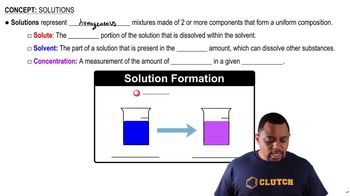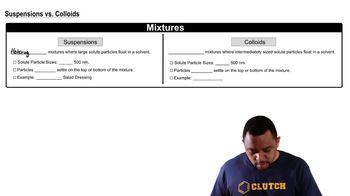Here are the essential concepts you must grasp in order to answer the question correctly.
Solution
A solution is a homogeneous mixture where one substance (the solute) is completely dissolved in another (the solvent). The particles of the solute are at the molecular or ionic level, making the solution clear and allowing light to pass through without scattering. Common examples include saltwater and sugar dissolved in water.
Recommended video:
Colloid
A colloid is a mixture where fine particles of one substance are dispersed within another, but not dissolved. These particles are larger than those in a solution, typically ranging from 1 nanometer to 1 micrometer, and they can scatter light, resulting in a phenomenon known as the Tyndall effect. Examples of colloids include milk, fog, and gelatin.
Recommended video:
Tyndall Effect
The Tyndall effect is the scattering of light by particles in a colloid or in very fine suspensions. This effect can be observed when a beam of light passes through a colloidal mixture, making the path of the light visible. It serves as a distinguishing feature between solutions and colloids, as solutions do not scatter light and appear clear.
Recommended video:
Solubility: Temperature Effect Concept 1
 Verified step by step guidance
Verified step by step guidance


